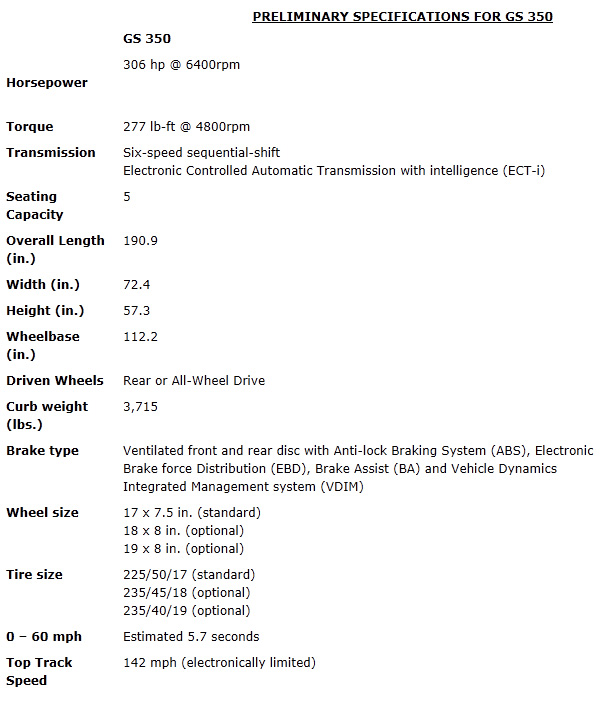Time is up for Lexus to pull the wraps off the third-generation GS luxury sedan that made its first outing today at the Pebble Beach Concours d’Elegance in California.
 Based on the LF-Gh concept we saw in New York, the new GS features much bolder lines that its predecessor. Key highlights include a prominent trapezoidal grille that the company says will be a trademark of all future models, deep-set headlamps with L-shaped LED daytime running lights and an aerodynamic body that brings to mind the smaller IS.
Based on the LF-Gh concept we saw in New York, the new GS features much bolder lines that its predecessor. Key highlights include a prominent trapezoidal grille that the company says will be a trademark of all future models, deep-set headlamps with L-shaped LED daytime running lights and an aerodynamic body that brings to mind the smaller IS.
Lexus’ Audi A6 and Mercedes-Benz E-Class challenger is underpinned by a revised platform that is more rigid thanks to the increased number of spot welds as well as laser welds in specific locations.
The engineers also redesigned the suspension, which features aluminum upper, and lower control arms for reduced unsprung weight and an updated rear subframe that supports a new multilink suspension.
The mid-size sedan also features wider tracks (+40 mm up front and +50 mm at the rear) and different shock absorbers with lighter-viscosity oil, allowing for faster response to small driver inputs. Braking is taken care of ventilated discs all around with four-piston calipers up front.
In Europe, Lexus will offer the entry level GS 250 (we presume equipped with the IS’s 2.5-liter V6 as the company did not reveal any specific details) and a GS 450h full-hybrid version, whereas in the US the line-up will include the GS 350 and the GS 450h.
The North American market GS 350 is motivated by a 3.5-liter V6 generating 306-horsepower and 277-pound-feet of torque, enough to propel the premium sedan from 0 to 60mph (96km/h) in 5.7 seconds and on to a top speed of 142mph (228 km/h). Acceleration from 30 to 50 mph takes 3.0 seconds. The V6 engine is linked to a six-speed sequential shift automatic transmission with paddle shifters and sport driving functions as standard equipment.
 Lexus will offer the GS 350 in both rear-wheel and all-wheel drive versions. According to the Japanese automaker, the optional electronically controlled all-wheel-drive system can vary front-to-rear torque balance from 50/50 to as much as 30/70, depending on driving conditions.
Lexus will offer the GS 350 in both rear-wheel and all-wheel drive versions. According to the Japanese automaker, the optional electronically controlled all-wheel-drive system can vary front-to-rear torque balance from 50/50 to as much as 30/70, depending on driving conditions.
Although its dimensions are almost identical to the outgoing model, the new Lexus GS offers improved space in the cabin, while boot capacity has been increased by 25%. Entry and exit are made easier thanks to wider door openings and the redesigned seat frame and steering column give the driver better visibility as well as increased comfort.
The dashboard’s design bears no relation to that of the outgoing GS, with the styling clearly inspired from the LF-A sportscar.
It features cleaner lines while highlights include the extra-large touchscreen (up to 12.3 inches) and the relocated controls for the audio (a 17-speaker Mark Levinson, if you tick the options box) and climate system. The latter uses a new, energy saving technology called S-Flow with an occupant-detection system to direct airflow only to the front area where passengers are actually seated.
In this class, a multimedia all-in-one control system is practically compulsory and the new GS has its own “next generation Remote Touch with one-push confirmation” as standard for “intuitive operation of climate, audio and phone controls as well as the navigation system” (Lexus’ words, not ours…).
In terms of safety, the new GS features a huge array of both passive and active safety features. There are 10 airbags in total, including knee ones for both driver and front passenger and side airbags for rear passengers.
The new GS can be equipped with a pre-collision system that uses the radar cruise control system to detect a probable accident and an infrared camera that monitors the driver’s eyes. If it detects that he is not looking forward when road circumstances suggest that an accident is probable, it sounds an alarm. If the driver doesn’t respond the system will automatically activate the brakes, reducing the severity of the impact.
Lexus said that it will also offer an F-Sport Package with styling and chassis upgrades.
According to the Japanese company, GS production will start in December with the first cars arriving in showrooms in February.
PHOTO GALLERY



![2013 Lexus GS Officially Unveiled at the Pebble Beach Festival [47 Photos + Video]](https://www.carscoops.com/wp-content/uploads/2011/08/2013-Lexus-GS-31.jpg)
















































